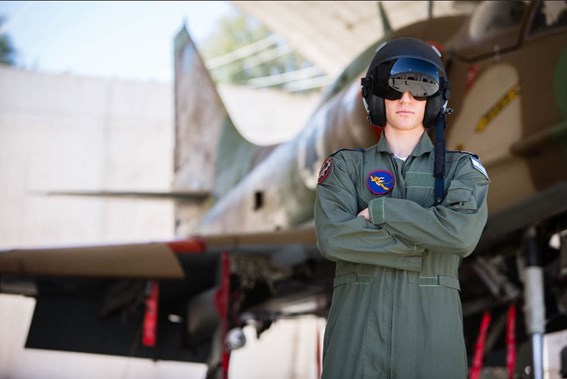Find Out What it Takes to Become a World-Class Fighter Pilot
Exclusively on the IDF Blog, an IAF fighter pilot faces the camera and talks about the challenging training he endured to become a pilot. He takes us through the trying yet strengthening moments all the way to the exhilarating and rewarding accomplishment of receiving his pilot’s wings. Meet Lt. G, who at age 22, can be proud to call himself a pilot in the IAF.

Becoming an IAF Pilot
Flying an airplane. Gaining height slowly, until all you can see are clouds; this is the dream of countless IDF soldiers, yet only a handful of them actually fulfill it. Even fewer manage to finish the three year-long training, which is one of the most selective in the IDF. Even before drafting into the army, the young aspiring pilots are challenged with various tests and are required to meet the course’s high evaluation standards: medical examinations, flight simulations, a complex psychometric exam and an in-depth psychological interview.
The best candidates will then go to a “gibush”, a tryout week of exams that determines which of them will ultimately gain a spot in the IAF’s Pilot’s Course.
Flying Solo
“Flying an airplane is exhilarating,” exclaims Lt. G. “You start the engine, find yourself glued to the back of your seat, the airplane leaves the runway and then –you’re up in the air! It’s an incredible feeling when for the first time, you are finally the one in control of the plane and it follows your command.”
“When in the air, your heart rate goes way up because you are constantly focused and give your 100%. It’s such a feeling of power,” the young pilot asserts. “The expression ‘on cloud nine’ becomes so real.”

”You have to be consistently good, but you’re never good enough.”
Being selected for the IAF’s Pilot’s Course does not guarantee that one will necessarily become a pilot. “Nothing is easy. During the entire course, I was sure I was going to flunk,” Lt. G. admits. “There were many times when I cracked, where everything seemed impossible.”
One significant emotional challenge the course presents its cadets is the uncertainty they face on a daily basis. “You have to be consistently good but you’re never good enough,” he explains. “The day I learned that I had been selected to participate in the training, I was the happiest in the world.”
To Lt. G, one of the most cherished aspects of training is the close bonds that he forged with the rest of the cadets. “It is true that the atmosphere [in the course] is competitive,” he says. “But it’s more of a competition between you and yourself, because you want to give the best you can. Many of my friends didn’t make it through to the end of the course, which was very upsetting. These are people with whom I spent all of my days: we slept in the same tent together all of the first year of training, we studied, we trained together… and suddenly they were gone. But this training does not really allow you to fall apart. We must keep cool and move forward.”
Finally Receiving His Wings
“The most moving part of my journey was when I was awarded with my pilot’s wings. I went up to the stands, surrounded by my family and my relatives,” recalls Lt. G. “That moment really moved me.”
When the soldiers finally complete their training, they commit to serving in the IDF for nine years, and contrary to what one might think, they are still far from being operational fighter pilots. It is only at that point that they enter advanced training – which lasts about two years – and only then are they allowed to participate in IDF operational activities.
Maturity and Responsibility
The three years of intense training are not just designed to prepare a new generation of soldiers to become IAF pilots– they also teach these young men responsibility, maturity and professionalism. “This is for our country,” Pilot G affirms. “This is why we serve in the military. Our mission is to ensure the safety of this country and to enable its citizens to live in peace.”

